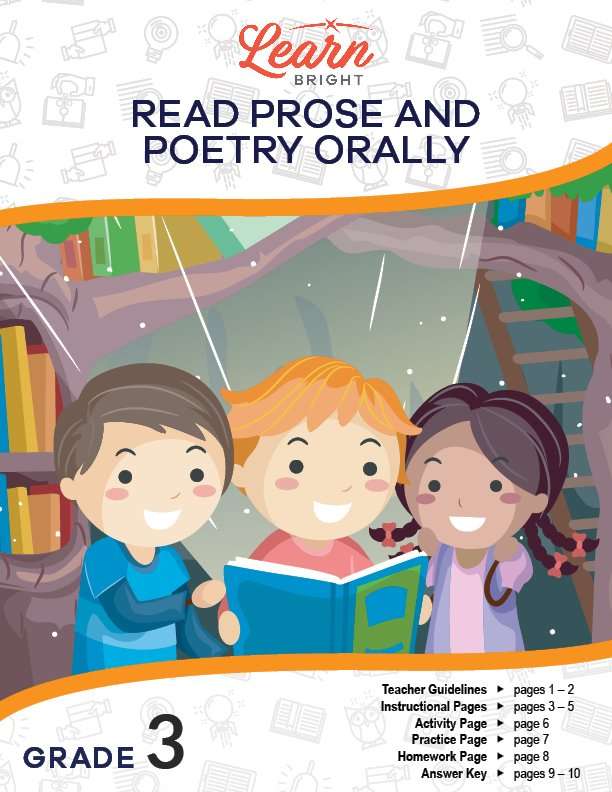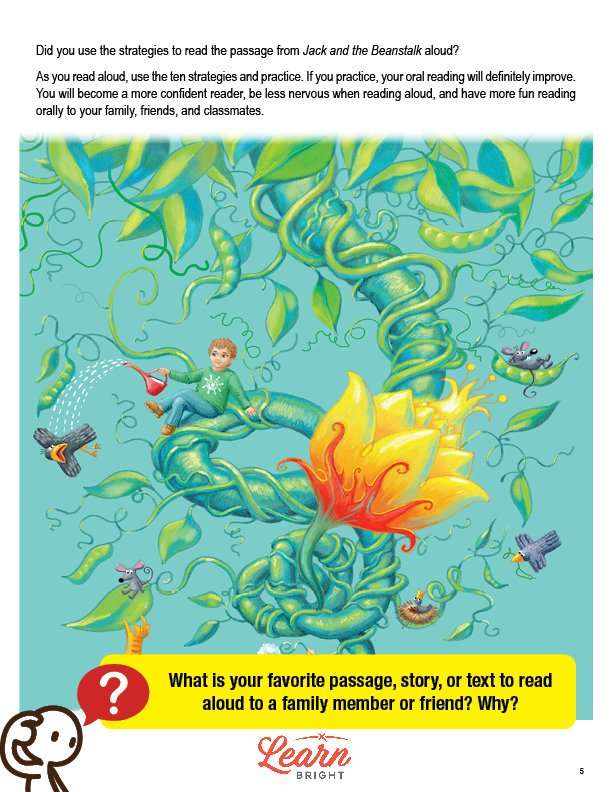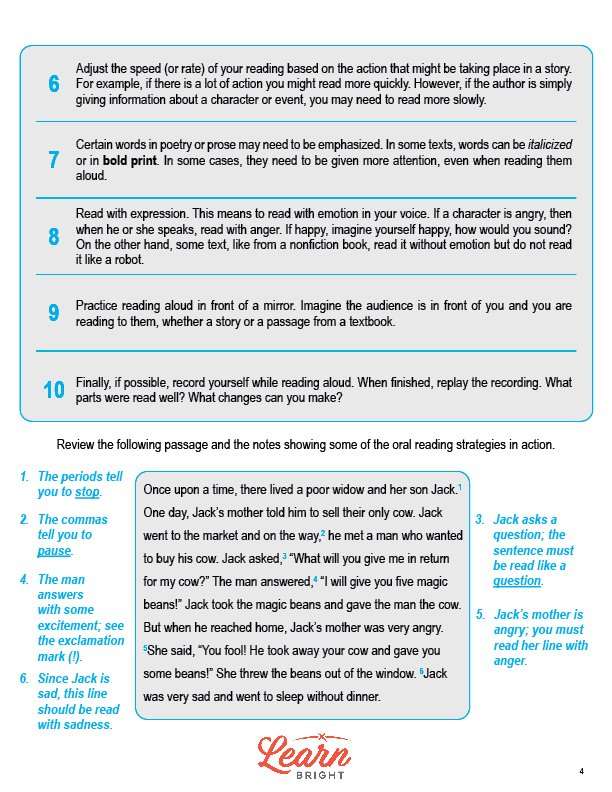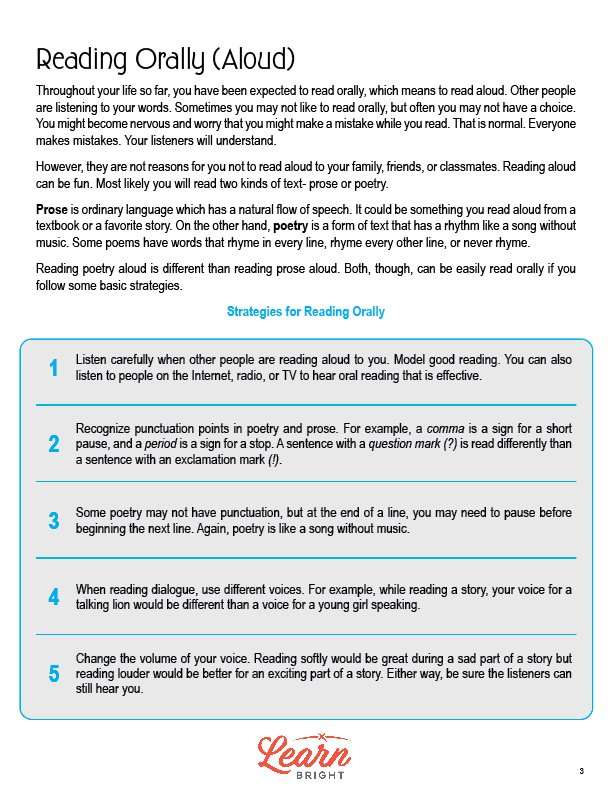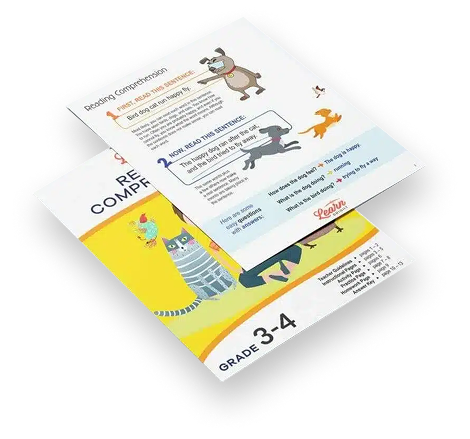Description
What our Read Prose and Poetry Orally lesson plan includes
Lesson Objectives and Overview: Read Prose and Poetry Orally teaches students strategies for effective reading poetry aloud. At the end of the lesson, students will be able to read grade-level prose and poetry orally with accuracy, appropriate rate, and expression on successive readings. This lesson is for students in 3rd grade.
Classroom Procedure
Every lesson plan provides you with a classroom procedure page that outlines a step-by-step guide to follow. You do not have to follow the guide exactly. The guide helps you organize the lesson and details when to hand out worksheets. It also lists information in the yellow box that you might find useful. You will find the lesson objectives, state standards, and number of class sessions the lesson should take to complete in this area. In addition, it describes the supplies you will need as well as what and how you need to prepare beforehand. For this lesson, the supplies you will need are passages and poems for the activity and the handouts. To prepare for this lesson ahead of time, you can pair students for the activity, find the passages and poems for the activity, and copy the handouts.
Options for Lesson
Included with this lesson is an “Options for Lesson” section that lists a number of suggestions for activities to add to the lesson or substitutions for the ones already in the lesson. For the activity worksheet, an optional adjustment is to have students choose their own reading passages. A possible addition to this lesson is to have each student read either a poem or a passage aloud to the entire class and have their classmates use the provided checklist to rate each other. You can also write various emotions down on slips of paper, put them in a container, and have students choose one and then read a line of text using that emotion. Students could also read a whole story aloud, reading each line one by one. Finally, you could have pairs of students read lines together, first on their own and then to the whole class.
Teacher Notes
The teacher notes page includes a paragraph with additional guidelines and things to think about as you begin to plan your lesson. It notes that some of your students may have a fear of reading aloud, and that you may need to help those students address those fears during this lesson. This page also includes lines that you can use to add your own notes as you’re preparing for this lesson.
READ PROSE AND POETRY ORALLY LESSON PLAN CONTENT PAGES
Reading Orally (Aloud)
The Read Prose and Poetry Orally lesson plan includes three content pages. The lesson begins by reminding students that they likely have already read something aloud in the past. Some students may not like having to read aloud, as they are afraid that they will make a mistake. However, it is important to understand that everyone makes mistakes sometimes! Reading aloud, with family, friends, or classmates, can be fun. The two types of text that students will likely read aloud are poetry and prose.
Prose is normal language which has a natural flow of speech. This could be a passage from a textbook or a story. Poetry is a form of text that has a rhythm. They’re kind of like songs with no music! Poems can have words that rhyme in every line, rhyme in every other line, or don’t rhyme at all. We read these two kinds of text aloud in different ways. However, there are many strategies for reading aloud that apply to both.
Strategies for Reading Orally
The next section of this lesson delves into some of the strategies that students can use to read orally. The first strategy is to listen carefully when other people are reading aloud and try to model what they do well. It’s also helpful to listen to people on the internet, radio, or on TV to hear effective oral reading.
The second strategy is to pay attention to punctuation and understand what different punctuation marks mean for reading aloud. For example, when you see a comma you should take a short pause. You read sentences that end with a question mark differently than those that end with an exclamation point.
The third strategy is understanding that poetry may not be punctuated in the same way that prose is. Some poetry may have no punctuation at all, but you still need to pause between lines.
The fourth strategy is to use different voices when reading dialogue aloud. The voice you use for a talking lion, for example, should be different from the voice you use for a young girl.
The fifth strategy is to change the volume of your voice. During a sad part of a story, you may want to speak softly. For an exciting part, you should speak louder. However, the most important thing is to read clearly and loud enough so that your listeners can hear you.
More Strategies
The next section of this lesson delves into a few more strategies for reading aloud. The sixth strategy presented in this lesson suggests that you change the speed (or rate) that you read based on what’s happening in the story. You might want to read faster if a lot of action is happening.
The seventh strategy is to emphasize certain words as necessary. You can usually tell which words need to be emphasized because they might be either bolded or italicized.
The eighth strategy is to read with expression, which means that you should read with emotion in your voice. For example, if a character is angry, read with anger in your voice. If they’re happy, read in a happy way. You can imagine how you would sound if you were feeling those emotions and base your reading off of that. If the text doesn’t have a particular emotion associated with it, like a nonfiction book, you should still read with some emotion to avoid sounding like a robot while reading.
The ninth strategy is to practice reading aloud in front of a mirror while imagining that you have an audience. The tenth, and final, strategy is to record yourself reading aloud and replay the recording. This will help you identify which parts you read well and which parts need work.
Next, students will read an example passage and some notes on how the passage should be read. This example will help them identify some common things that they should notice when reading aloud. They should then practice reading the example passage aloud using the ten strategies outlined in this lesson. The more you read aloud, the better and more confident you will get!
READ PROSE AND POETRY ORALLY LESSON PLAN WORKSHEETS
The Read Prose and Poetry Orally lesson plan includes three worksheets: an activity worksheet, a practice worksheet, and a homework assignment. You can refer to the guide on the classroom procedure page to determine when to hand out each worksheet.
READING EVALUATION ACTIVITY WORKSHEET
Students will work in pairs to complete this activity. Each pair will receive both a poem and a prose passage from their teacher and will take turns reading them aloud to each other. The students will evaluate each other using a provided checklist. They will then discuss any aspects that need improvement. The students may practice reading the passages to themselves before reading them aloud.
Students may also work either alone or in larger groups for this activity if you’d prefer.
READING ALOUD PRACTICE WORKSHEET
For the practice worksheet, students will complete three sections. The first section asks them to answer ten questions related to reading aloud. The second section asks them to identify the emotion that they would use when reading various lines aloud. Finally, the third section asks them what their favorite emotion to use while reading is and why.
READ PROSE AND POETRY ALOUD HOMEWORK ASSIGNMENT
The homework assignment asks students to first circle the correct rate, voice, or volume that they should use when reading specific lines aloud. Next, they will read a short poem aloud to themselves and evaluate themselves using a given checklist. They will then read the same poem aloud to an adult and have that adult evaluate them.
Worksheet Answer Keys
This lesson plan includes answer keys for the practice worksheet and the homework assignment. No answer key is provided for the activity worksheet, as students’ answers will vary. If you choose to administer the lesson pages to your students via PDF, you will need to save a new file that omits these pages. Otherwise, you can simply print out the applicable pages and keep these as reference for yourself when grading assignments.

